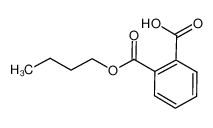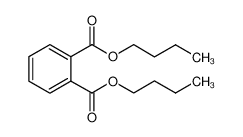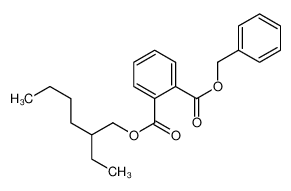1.Identification
1.1 GHS Product identifier
| Product name | Benzyl butyl phthalate |
|---|
1.2 Other means of identification
| Product number | - |
|---|---|
| Other names | BBP |
1.3 Recommended use of the chemical and restrictions on use
| Identified uses | For industry use only. Plasticizers |
|---|---|
| Uses advised against | no data available |
1.4 Supplier's details
| Company | MOLBASE (Shanghai) Biotechnology Co., Ltd. |
|---|---|
| Address | Floor 4 & 5, Building 12, No. 1001 North Qinzhou Road, Xuhui District, Shanghai, China |
| Telephone | +86(21)64956998 |
| Fax | +86(21)54365166 |
1.5 Emergency phone number
| Emergency phone number | +86-400-6021-666 |
|---|---|
| Service hours | Monday to Friday, 9am-5pm (Standard time zone: UTC/GMT +8 hours). |
2.Hazard identification
2.1 Classification of the substance or mixture
Hazardous to the aquatic environment, short-term (Acute) - Category Acute 1
Hazardous to the aquatic environment, long-term (Chronic) - Category Chronic 1
Reproductive toxicity, Category 1B
2.2 GHS label elements, including precautionary statements
| Pictogram(s) |   |
|---|---|
| Signal word | Danger |
| Hazard statement(s) | H410 Very toxic to aquatic life with long lasting effects H360Df |
| Precautionary statement(s) | |
| Prevention | P273 Avoid release to the environment. P201 Obtain special instructions before use. P202 Do not handle until all safety precautions have been read and understood. P280 Wear protective gloves/protective clothing/eye protection/face protection. |
| Response | P391 Collect spillage. P308+P313 IF exposed or concerned: Get medical advice/ attention. |
| Storage | P405 Store locked up. |
| Disposal | P501 Dispose of contents/container to ... |
2.3 Other hazards which do not result in classification
none
3.Composition/information on ingredients
3.1 Substances
| Chemical name | Common names and synonyms | CAS number | EC number | Concentration |
|---|---|---|---|---|
| Benzyl butyl phthalate | Benzyl butyl phthalate | 85-68-7 | none | 100% |
4.First-aid measures
4.1 Description of necessary first-aid measures
General advice
Consult a physician. Show this safety data sheet to the doctor in attendance.
If inhaled
Fresh air, rest.
In case of skin contact
Remove contaminated clothes. Rinse and then wash skin with water and soap.
In case of eye contact
First rinse with plenty of water for several minutes (remove contact lenses if easily possible), then refer for medical attention.
If swallowed
Rinse mouth.
4.2 Most important symptoms/effects, acute and delayed
Prolonged contact with liquid causes some irritation of eyes and skin. (USCG, 1999)
4.3 Indication of immediate medical attention and special treatment needed, if necessary
Immediate first aid: Ensure that adequate decontamination has been carried out. If patient is not breathing, start artificial respiration, preferably with a demand-valve resuscitator, bag-valve-mask device, or pocket mask, as trained. Perform CPR as necessary. Immediately flush contaminated eyes with gently flowing water. Do not induce vomiting. If vomiting occurs, lean patient forward or place on left side (head-down position, if possible) to maintain an open airway and prevent aspiration. Keep patient quiet and maintain normal body temperature. Obtain medical attention. /Esters and related compounds/
5.Fire-fighting measures
5.1 Extinguishing media
Suitable extinguishing media
To fight fire, use spray or mist, carbon dioxide, dry chemical.
5.2 Specific hazards arising from the chemical
Special Hazards of Combustion Products: Irritating vapors of unburned chemical may form in fires. (USCG, 1999)
5.3 Special protective actions for fire-fighters
Wear self-contained breathing apparatus for firefighting if necessary.
6.Accidental release measures
6.1 Personal precautions, protective equipment and emergency procedures
Use personal protective equipment. Avoid dust formation. Avoid breathing vapours, mist or gas. Ensure adequate ventilation. Evacuate personnel to safe areas. Avoid breathing dust. For personal protection see section 8.
6.2 Environmental precautions
Personal protection: filter respirator for organic gases and vapours adapted to the airborne concentration of the substance. Do NOT let this chemical enter the environment. Collect leaking and spilled liquid in sealable containers as far as possible. Absorb remaining liquid in sand or inert absorbent. Then store and dispose of according to local regulations.
6.3 Methods and materials for containment and cleaning up
Environmental considerations-land spill: Dig a pit, pond, lagoon, holding area to contain liquid or solid material. Dike surface flow using soil, sand bags, foamed polyurethane, or foamed concrete. Absorb bulk liquid with fly ash, cement powder, or commercial sorbents. /SRP: If time permits, pits, ponds, lagoons, soak holes, or holding areas should be sealed with an impermeable flexible membrane liner./
7.Handling and storage
7.1 Precautions for safe handling
Avoid contact with skin and eyes. Avoid formation of dust and aerosols. Avoid exposure - obtain special instructions before use.Provide appropriate exhaust ventilation at places where dust is formed. For precautions see section 2.2.
7.2 Conditions for safe storage, including any incompatibilities
Store in an area without drain or sewer access. Separated from strong oxidants.Keep container tightly closed in a dry and well-ventilated place. Containers which are opened must be carefully resealed and kept upright to prevent leakage. Storage class (TRGS 510): Non-combustible, acute toxic Cat.3 / toxic hazardous materials or hazardous materials causing chronic effects
8.Exposure controls/personal protection
8.1 Control parameters
Occupational Exposure limit values
no data available
Biological limit values
no data available
8.2 Appropriate engineering controls
Handle in accordance with good industrial hygiene and safety practice. Wash hands before breaks and at the end of workday.
8.3 Individual protection measures, such as personal protective equipment (PPE)
Eye/face protection
Safety glasses with side-shields conforming to EN166. Use equipment for eye protection tested and approved under appropriate government standards such as NIOSH (US) or EN 166(EU).
Skin protection
Wear impervious clothing. The type of protective equipment must be selected according to the concentration and amount of the dangerous substance at the specific workplace. Handle with gloves. Gloves must be inspected prior to use. Use proper glove removal technique(without touching glove's outer surface) to avoid skin contact with this product. Dispose of contaminated gloves after use in accordance with applicable laws and good laboratory practices. Wash and dry hands. The selected protective gloves have to satisfy the specifications of EU Directive 89/686/EEC and the standard EN 374 derived from it.
Respiratory protection
Wear dust mask when handling large quantities.
Thermal hazards
no data available
9.Physical and chemical properties
| Physical state | colourless oily liquid |
|---|---|
| Colour | Clear, oil liquid |
| Odour | Slight odor |
| Melting point/ freezing point | 220°C(dec.)(lit.) |
| Boiling point or initial boiling point and boiling range | 250°C/22.5mmHg(lit.) |
| Flammability | Combustible. Gives off irritating or toxic fumes (or gases) in a fire. |
| Lower and upper explosion limit / flammability limit | no data available |
| Flash point | 113°C |
| Auto-ignition temperature | 232.22°C |
| Decomposition temperature | no data available |
| pH | no data available |
| Kinematic viscosity | no data available |
| Solubility | In water:0.000269 g/100 mL |
| Partition coefficient n-octanol/water (log value) | log Kow = 4.73 |
| Vapour pressure | 0.16 mm Hg ( 150 °C) |
| Density and/or relative density | 1.1g/mLat 25°C(lit.) |
| Relative vapour density | 10.8 (vs air) |
| Particle characteristics | no data available |
10.Stability and reactivity
10.1 Reactivity
no data available
10.2 Chemical stability
Stable under recommended storage conditions.
10.3 Possibility of hazardous reactions
CombustibleBUTYL BENZYL PHTHALATE is an ester. Esters react with acids to liberate heat along with alcohols and acids. Strong oxidizing acids may cause a vigorous reaction that is sufficiently exothermic to ignite the reaction products. Heat is also generated by the interaction of esters with caustic solutions. Flammable hydrogen is generated by mixing esters with alkali metals and hydrides. Can generate electrostatic charges. [Handling Chemicals Safely 1980. p. 250].
10.4 Conditions to avoid
no data available
10.5 Incompatible materials
Incompatible with strong acids, nitrates, oxidizers.
10.6 Hazardous decomposition products
When heated to decomposition, it emits acrid smoke and irritating fumes.
11.Toxicological information
Acute toxicity
- Oral: LD50 Rat oral 2330 mg/kg
- Inhalation: no data available
- Dermal: no data available
Skin corrosion/irritation
no data available
Serious eye damage/irritation
no data available
Respiratory or skin sensitization
no data available
Germ cell mutagenicity
no data available
Carcinogenicity
CLASSIFICATION: C; possible human carcinogen. BASIS FOR CLASSIFICATION: Based on statistically significant increase in mononuclear cell leukemia in female rats; the response in male rats was inconclusive and there was no such response in mice. HUMAN CARCINOGENICITY DATA: None. ANIMAL CARCINOGENICITY DATA: Limited.
Reproductive toxicity
no data available
STOT-single exposure
no data available
STOT-repeated exposure
no data available
Aspiration hazard
no data available
12.Ecological information
12.1 Toxicity
- Toxicity to fish: LC50; Species: Lepomis macrochirus (Bluegill) young of year, weight 0.32-1.2 g; Conditions: freshwater, static, 21-23°C, pH 6.5-7.9, hardness 32-48 mg/L CaCO3, alkalinity 28-34 mg/L CaCO3, conductivity 93-190 umhos/cm, dissolved oxygen 0.3-9.7 mg/L; Concentration: 62000 ug/L for 24 hr /> or = 80% purity
- Toxicity to daphnia and other aquatic invertebrates: EC50; Species: Daphnia magna (water flea); Conditions: static, 22.5 + or -0.5°C, pH ranged from 8.4 to 8.5 at initiation and ranged from 8.3 to 8.4 on day 2; Concentration: >0.96 mg/L for 48 hr; Effect: % immobility
- Toxicity to algae: EC50; Species: Pseudokirchneriella subcapitata (Green algae); Conditions: freshwater, static, 22-24°C, pH 7.6-7.9, hardness 25-50 mg/L CaCO3, alkalinity 25-50 mg/L CaCO3; Concentration: 210 ug/L for 48 hr; Effect: decreased population abundance /> or = 95% purity
- Toxicity to microorganisms: no data available
12.2 Persistence and degradability
AEROBIC: Butyl benzyl phthalate was degraded 74-79% in 10-50 days at 25°C from an initial concentration of 100 mg/L, using 30 mg/L activated sludge(1). Butyl benzyl phthalate was completely biodegraded in Rhine River water over a 6 day incubation period(2). Butyl benzyl phthalate incubated in a lake water/sediment microcosm biodegraded to intermediates with a half-life of 5 days and was completely biodegraded with a half-life of about 13 days, when incubated in river water a half-life of 2 days was reported for the degradation to intermediates(3). Butyl benzyl phthalate was biodegraded 93 and >99% using a semi-continuous activated sludge with starting concentrations of 3.3 and 133.3 mg/L, respectively(4). Butyl benzyl phthalate had half-lives of 1.5 and 0.32 days in river die-away tests with a starting concentration of 1 mg/L and 1 ug/L, and a half-life of 1.4 days using a lake microcosm(5). Butyl benzyl phthalate, at a concentration of 20 ppm, digested for 28 days had 87% degradation(6). Using a fresh water inoculum, butyl benzyl phthalate was degraded 100% in 7 days from a starting concentration of 1 ppm(6). Butyl benzyl phthalate, present at 100 mg/L, reached 80.9% of its theoretical BOD in 2 weeks using an activated sludge inoculum at 30 mg/L in the Japanese MITI test(7).
12.3 Bioaccumulative potential
Bluegill sunfish (Lepomis macrochirus) exposed to 9.73 ug/L of C14 labeled butyl benzyl phthalate for 21 days had a measured BCF values of 663 and 772(1). However, these studies used total radioactive residues in whole fish to calculate the BCF; the metabolism of butyl benzyl phthalate in the fish was not considered(1). Bluegill sunfish exposed to uniformly ring labeled butyl benzyl phthalate for 3.27 days had a BCF of 9.4(1). According to a classification scheme(2), BCF values of zero to 30 are low and from 100 to 1,000 are high. Biota-sediment accumulation factors for butyl benzyl phthalate were 4.3, 4.6 and 2.8 in roach (Rutilus rutilus), chub (Leuciscus cephalus) and perch (Perca fluviatilis), respectively; fish were collected from the Orge River, France from Jul 2009 to Apr 2010(3). BCFs of 0.13-45 were reported for butyl benzyl phthalate in water spinach (Ipomoea aquatica) grown under different conditions on sludge from waste water treatment plants in China(4).
12.4 Mobility in soil
A log Koc value of 3.3 was measured from unsaturated soil columns at pH 4.8(1). Other experimental log Koc values given are 3.21(2) and 3.997(3). According to a classification scheme(4), these Koc values suggest that butyl benzyl phthalate is expected to have low to no mobility in soil. An experimental log Koc of >4.7 was determined from sediment samples from Lake Yssel, the Netherlands(5).
12.5 Other adverse effects
no data available
13.Disposal considerations
13.1 Disposal methods
Product
The material can be disposed of by removal to a licensed chemical destruction plant or by controlled incineration with flue gas scrubbing. Do not contaminate water, foodstuffs, feed or seed by storage or disposal. Do not discharge to sewer systems.
Contaminated packaging
Containers can be triply rinsed (or equivalent) and offered for recycling or reconditioning. Alternatively, the packaging can be punctured to make it unusable for other purposes and then be disposed of in a sanitary landfill. Controlled incineration with flue gas scrubbing is possible for combustible packaging materials.
14.Transport information
14.1 UN Number
| ADR/RID: UN3082 | IMDG: UN3082 | IATA: UN3082 |
14.2 UN Proper Shipping Name
| ADR/RID: ENVIRONMENTALLY HAZARDOUS SUBSTANCE, LIQUID, N.O.S. |
| IMDG: ENVIRONMENTALLY HAZARDOUS SUBSTANCE, LIQUID, N.O.S. |
| IATA: ENVIRONMENTALLY HAZARDOUS SUBSTANCE, LIQUID, N.O.S. |
14.3 Transport hazard class(es)
| ADR/RID: 9 | IMDG: 9 | IATA: 9 |
14.4 Packing group, if applicable
| ADR/RID: III | IMDG: III | IATA: III |
14.5 Environmental hazards
| ADR/RID: yes | IMDG: yes | IATA: yes |
14.6 Special precautions for user
no data available
14.7 Transport in bulk according to Annex II of MARPOL 73/78 and the IBC Code
no data available
15.Regulatory information
15.1 Safety, health and environmental regulations specific for the product in question
| Chemical name | Common names and synonyms | CAS number | EC number |
|---|---|---|---|
| Benzyl butyl phthalate | Benzyl butyl phthalate | 85-68-7 | none |
| European Inventory of Existing Commercial Chemical Substances (EINECS) | Listed. | ||
| EC Inventory | Listed. | ||
| United States Toxic Substances Control Act (TSCA) Inventory | Listed. | ||
| China Catalog of Hazardous chemicals 2015 | Not Listed. | ||
| New Zealand Inventory of Chemicals (NZIoC) | Listed. | ||
| Philippines Inventory of Chemicals and Chemical Substances (PICCS) | Listed. | ||
| Vietnam National Chemical Inventory | Listed. | ||
| Chinese Chemical Inventory of Existing Chemical Substances (China IECSC) | Listed. | ||
16.Other information
Information on revision
| Creation Date | Aug 12, 2017 |
|---|---|
| Revision Date | Aug 12, 2017 |
Abbreviations and acronyms
- CAS: Chemical Abstracts Service
- ADR: European Agreement concerning the International Carriage of Dangerous Goods by Road
- RID: Regulation concerning the International Carriage of Dangerous Goods by Rail
- IMDG: International Maritime Dangerous Goods
- IATA: International Air Transportation Association
- TWA: Time Weighted Average
- STEL: Short term exposure limit
- LC50: Lethal Concentration 50%
- LD50: Lethal Dose 50%
- EC50: Effective Concentration 50%
References
- IPCS - The International Chemical Safety Cards (ICSC), website: http://www.ilo.org/dyn/icsc/showcard.home
- HSDB - Hazardous Substances Data Bank, website: https://toxnet.nlm.nih.gov/newtoxnet/hsdb.htm
- IARC - International Agency for Research on Cancer, website: http://www.iarc.fr/
- eChemPortal - The Global Portal to Information on Chemical Substances by OECD, website: http://www.echemportal.org/echemportal/index?pageID=0&request_locale=en
- CAMEO Chemicals, website: http://cameochemicals.noaa.gov/search/simple
- ChemIDplus, website: http://chem.sis.nlm.nih.gov/chemidplus/chemidlite.jsp
- ERG - Emergency Response Guidebook by U.S. Department of Transportation, website: http://www.phmsa.dot.gov/hazmat/library/erg
- Germany GESTIS-database on hazard substance, website: http://www.dguv.de/ifa/gestis/gestis-stoffdatenbank/index-2.jsp
- ECHA - European Chemicals Agency, website: https://echa.europa.eu/










